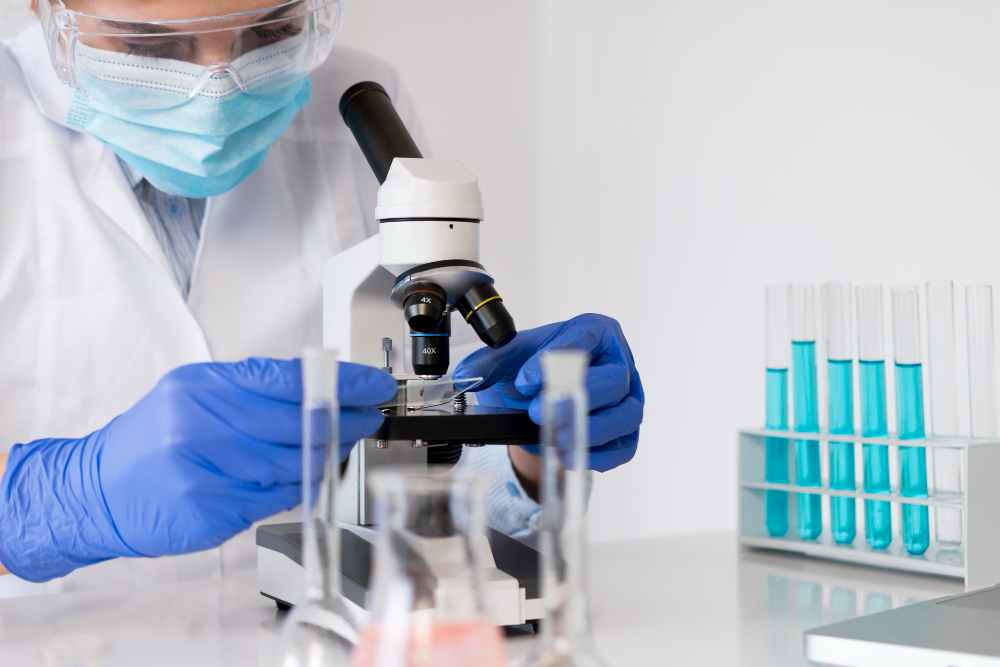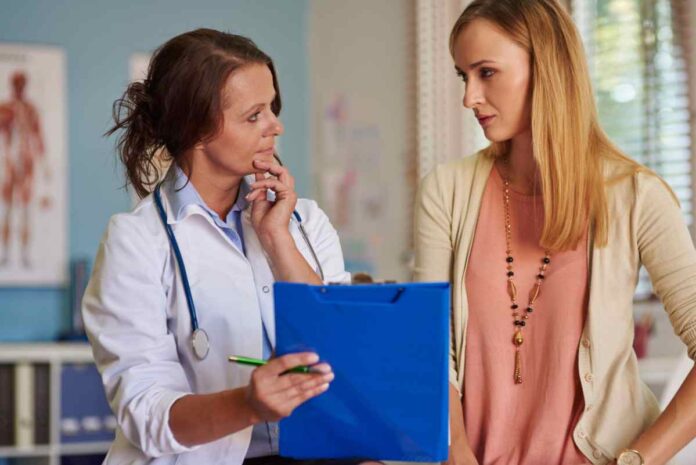Estrogen refers to group of hormones, which play a crucial role in the development and functioning of the female reproductive system. The main estrogen hormone in the body is called estradiol, although there are other forms of estrogen, such as estrone and estriol.
Estrogen is produced primarily in the ovaries, although small amounts are also produced by the adrenal glands and in smaller amounts by the placenta during pregnancy. In men, estrogen is produced in smaller amounts by the testicles.
Types of estrogen and their role in the body
The estrogenic group of hormones includes several different types of estrogenic compounds. The main estrogen hormone in the body is estradiol, but there are other forms as well. The main estrogens are:
Estradiol (E2): This is the most potent and predominant form of estrogen in premenopausal women. It is mainly produced in the ovaries and is responsible for the development and maintenance of female secondary sexual characteristics and the regulation of the menstrual cycle.
Estrone (E1): Estrone is a weaker form of estrogen compared to estradiol. It is produced in a variety of tissues, including the ovaries, adipose tissue, and adrenal glands. After the menopause estrone becomes the main estrogen produced by the body.
Estriol (E3): Estriol is the weakest form of estrogen and is produced in significant amounts amounts during pregnancy. It is mainly produced by the placenta and helps to maintain the pregnancy and prepare the body for birth.
These three estrogens, estradiol, estrone and estriol, make up the main group of estrogen hormones in the human body. The balance between these estrogens is important for normal physiological functions.
In addition, there are synthetic estrogens used in hormone therapy. These are, for example, ethinyl estradiol, which is commonly used in oral contraceptives. However, it is important to note that synthetic estrogens may have different properties and effects compared to natural estrogens. Their use should be carefully monitored by medical professionals.
What is the role of estrogen in the body?
The hormone affects the development of secondary sexual characteristics. With its help, women's breasts grow, hips expand. It also affects the distribution of body fat in a typically female pattern.
Another important process involved is the regulation of the menstrual cycle. Estrogen helps stimulate the growth and development of the lining of the uterus (endometrium) during the menstrual cycle. It also plays a role in regulating the menstrual cycle by interacting with other hormones, such as follicle-stimulating hormone (FSH) and luteinizing hormone (LH), which are involved in ovulation.
Maintenance of the reproductive system and bones
Estrogen helps maintain the health and function of the female reproductive organs, including the uterus, fallopian tubes, and vagina. It also promotes the production of cervical mucus, which facilitates the movement of sperm through the reproductive tract.
Bone health: Estrogen helps maintain proper bone density by inhibiting bone resorption. It plays a crucial role in preventing bone loss and osteoporosis, especially during menopause when estrogen levels drop.
Cardiovascular health and the brain
Estrogen has a protective effect on the cardiovascular system, promoting healthy blood vessel function and maintaining optimal cholesterol levels. It may also help improve blood flow and reduce the risk of heart disease in premenopausal women.
Brain function: Estrogen affects various aspects of brain function, including mood, cognition, and memory. It is thought to have a neuroprotective effect and may help reduce the risk of age-related cognitive decline and neurodegenerative diseases.
Skin health: Estrogen contributes to the maintenance of elasticity, moisture and density of the skin. It plays a role in the repair and regeneration of skin cells.
Estrogen is also present in the body of men, although in small quantities
It is important to note that estrogen is also present, albeit in lower amounts, in men. In men, estrogen helps regulate bone density, cholesterol metabolism, and reproductive function.
Overall, estrogen plays a critical role in numerous physiological processes throughout a person's life, and its balance is essential for optimal health.
When is an estrogen test done?
Optimal estrogen levels in active premenopausal women can vary. It is important to understand that individual hormone levels can vary within normal limits. Estrogen levels are usually measured in picograms per milliliter (pg/mL) or picomoles per liter (pmol/L) in blood tests. The following are general guidelines for estrogen levels in premenopausal women:
Estradiol (E2): The optimal range for estradiol can vary by menstrual phase, as levels fluctuate throughout the menstrual cycle. However, in general the range is usually between 30 and 400 pg/mL (110-1470 pmol/L) during the follicular phase (before ovulation) and can increase to 100-600 pg/mL (370-2200 pmol/ L) during the luteal phase (after ovulation).
The ratio of estrogen to progesterone should also be monitored. In addition to absolute estrogen levels, the balance between estrogen and progesterone is important for optimal hormonal health. The ratio of estrogen to progesterone should ideally be balanced, with progesterone levels approximately 100-300 times lower than estrogen levels.
It is important to note that optimal hormone levels may vary from individual to individual. There may be slight variations due to factors such as age, overall health and individual hormone profiles. In addition, laboratory reference limits may also be different. You should always consult a medical professional to interpret the specific results and take them into account with the general state of health.
How does menopause affect estrogen levels?
Menopause is a natural biological process that occurs in women usually between the ages of 45 and 55, although the exact time can vary. During menopause, the ovaries gradually decrease their production of estrogen. Naturally, this leads to a drop in its levels. Eventually, menstrual cycles stop and a woman is considered to have reached menopause when she has gone 12 consecutive months without a period.
Hormonal changes during menopause cause estrogen levels to drop significantly. While estrogen levels can vary greatly among individuals, the following are general guidelines for estrogen levels during and after menopause:
Estradiol (E2): During menopause, estradiol levels can range from approximately 10 to 40 pg/mL (37-147 pmol/L). After that, levels may further drop to less than 10 pg/mL (37 pmol/L).
It is important to note that these are approximate ranges and hormone levels can vary from person to person. In addition, hormone levels can fluctuate during perimenopause, the transitional period leading up to menopause, which can last several years and is characterized by hormonal fluctuations and irregular menstrual cycles.

Determining what is considered "normal" for estrogen levels during and after menopause is complicated because optimal levels can vary depending on an individual's symptoms, overall health, and personal risk factors. Some women may experience symptoms of estrogen deficiency, such as hot flashes, vaginal dryness, or mood changes, which may prompt consideration of hormone therapy or other interventions.
It is recommended that women consult with a health professional who specializes in menopause or hormonal health to assess their individual condition, symptoms and overall health. Hormone testing and a comprehensive evaluation can help determine the appropriate course of action and potential interventions to address any symptoms or concerns related to estrogen levels during and after menopause.
Is it safe to increase menopausal estrogen levels through hormone pills or herbal remedies
The decision to increase estrogen levels during menopause through hormone pills or herbal remedies should be made in consultation with a health professional who specializes in menopause or hormone health. They can assess your individual circumstances, assess risks and benefits and provide personalized guidance. Here are some considerations to keep in mind.
Hormone pills or patches known as hormone replacement therapy (HRT)
They may be prescribed to relieve menopausal symptoms by supplementing estrogen levels. HRT can effectively relieve symptoms such as hot flashes, night sweats, vaginal dryness and mood swings. However, there are potential risks associated with HRT, including an increased risk of blood clots, stroke, heart disease, and breast cancer.
These risks may vary depending on factors such as age, general health, and length of hormone use. It is important to discuss the potential risks and benefits with your healthcare professional.
Bioidentical Hormone Therapy (BHT)
This is another approach. Bioidentical hormones are synthesized to have the same molecular structure as hormones naturally produced by the body. Some women choose bioidentical hormone therapy (BHT) as an alternative to traditional HRT. BHT includes personalized hormone prescriptions based on individual hormone testing and symptoms.
Although some women may find relief with BHT, it is important to note that the safety and efficacy of bioidentical hormones is still up for debate and more research is needed to fully understand their benefits and risks.
Herbs and herbal preparations to increase estrogen
Some women turn to herbal remedies or nutritional supplements to manage menopausal symptoms. Examples include black cohosh, soy isoflavones, and red clover. Although these natural remedies may provide relief for some women, the evidence regarding their effectiveness is mixed and they may not work for everyone. It is important to discuss the use of herbal medicines with your healthcare professional, as they may interact with other medicines and may have their own set of risks and side effects.
Ultimately, the decision to increase estrogen levels during menopause should be based on a careful assessment of individual symptoms, overall health, and risk factors. It's a good idea to have anything you take as additional medications or supplements under the supervision of a medical professional. He can provide appropriate guidance, monitor hormone levels and help manage any potential risks associated with hormone therapy or herbal medicines.
Editor Ina Dimitrova
Image by gpointstudio on Freepik


